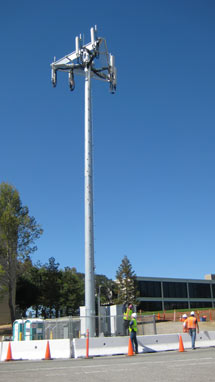
Handy Links
SLAC News Center
SLAC Today
- Subscribe
- Archives: Feb 2006-May 20, 2011
- Archives: May 23, 2011 and later
- Submit Feedback or Story Ideas
- About SLAC Today
SLAC News
Lab News
- Interactions
- Lightsources.org
- ILC NewsLine
- Int'l Science Grid This Week
- Fermilab Today
- Berkeley Lab News
- @brookhaven TODAY
- DOE Pulse
- CERN Courier
- DESY inForm
- US / LHC
SLAC Links
- Emergency
- Safety
- Policy Repository
- Site Entry Form

- Site Maps
- M & O Review
- Computing Status & Calendar
- SLAC Colloquium
- SLACspeak
- SLACspace
- SLAC Logo
- Café Menu
- Flea Market
- Web E-mail
- Marguerite Shuttle
- Discount Commuter Passes
-
Award Reporting Form
- SPIRES
- SciDoc
- Activity Groups
- Library
Stanford
Around the Bay
AT&T Cell Tower Update Coming Soon
The cell phone provider AT&T will move its SLAC-based cell phone tower from its temporary location behind Building 50 to its permanent home, with its antennae on the roof of the building. Construction is scheduled to begin soon and last into May. Tear-down of the old tower will not begin until the new site is operational, so as not to interrupt AT&T's service. SLAC employees should expect to see subcontractors working around Building 50 during the months of April and May.
"AT&T always intended the current tower to be temporary, and now they are following through to put a permanent tower in place," said Les Cottrell, SLAC's manager of computer networks and telecommunications and project manager for the AT&T project. "They want to do this right."
In 2008, SLAC management approached AT&T about joining the cell phone carriers T-mobile, Sprint and MetroPCS in providing a cell phone tower on the SLAC campus. The cell phone tower's antennae receive signals from cell phones and broadcast them to the carrier's nearest mobile telephone switching office, where they are connected to the service provider's backbone network. The signals going to and from the antennae can be interrupted by buildings or other obstructions, so they are usually placed high above the ground. In addition, each antenna can handle only a limited number of user signals, so the cell phone towers must be spaced close enough together to support the local volume of users.
Last summer, AT&T installed a temporary removable 50-foot tower and Base Transceiver Station, or BTS, with power supplies, backup batteries and electronics for the antenna array on the tower near Building 50. This was intended as a temporary fixture. The new location is considered more permanent, according to Mike Mangiantini of AT&T. Other than the new location, the antennae will not be undergoing any changes, so service should remain the same for AT&T users at SLAC.
Installment of the new antennae also requires AT&T to build a new BTS, housing the electronics necessary to power and operate the antennae, and a series of cables from the BTS up to the antennae. The BTS will be located in back of Building 50, on the south side. Removal of the old station is scheduled for completion in May.
While the project is funded by AT&T, SLAC still requires that it pass through the same planning and safety process used for all other construction projects at the lab. Any subcontractors who work on site must complete SLAC's safety training regimen.
"The SLAC Building Inspection Office has carefully reviewed the plans," Cottrell said. "You have to think about all the things that could possibly happen with an antenna—on a normal day, in a storm, in an earthquake—and make sure they can't happen. There is a very heavy emphasis on safety."
Watch SLAC Today for updates on the project.
—Calla Cofield
SLAC Today, April 12, 2011
